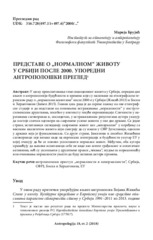Приказ основних података о документу
Predstave o normalnom životu u Srbiji posle 2000. Uporedni antropološki pregled
Тhe Representations of ‘normal’ life in Serbia after 2000. Comparative anthropological review
| dc.creator | Брујић, Марија | |
| dc.date.accessioned | 2023-02-12T22:25:07Z | |
| dc.date.available | 2023-02-12T22:25:07Z | |
| dc.date.issued | 2018 | |
| dc.identifier.issn | 1452-7243 | |
| dc.identifier.uri | http://reff.f.bg.ac.rs/handle/123456789/4237 | |
| dc.description.abstract | У циљу преиспитивања теме свакодневног живота у Србији, поредим две књиге о антропологији будућности и времена које су засноване на етнографском теренском раду о „нормалним животима“ после 2000-е у Србији (Жикић 2013) и Босни и Херцеговини (Jansen 2015). Главни циљ рада је да скрене пажњу на ове етнографске студије и да подстакне на поновљена истраживања „нормалности“ у постјугословенским друштвима, посебно у контексту текуће европеизације. Сличности у наративима саговорника и, последично, у истраживачким резултатима аутора указују да постоје слични одговори на савремене услове живота у ове две државе. Са једне стране, испитаници сагледавају савремени живот као „ненормалан“ у поређењу са високим квалитетом живота који сматрају да су имали у СФР Југославији, односно у држави која је функционисала. Са друге стране, Јансенови и посебно Жикићеви саговорници гаје велике наде од европских интеграција и будућности унутар ЕУ у којој очекују да ће се поново успоставити нормалан живот. Међутим, оба аутора примећују да њихови испитаници себе не виде као агенте грађанског и политичког активизма, већ су уклопљени у друштвене праксе „чекања“, жудње за нормалношћу или очекивања нормалности уместо да буду активни актери промена. | sr |
| dc.description.abstract | In order to focus on the issue of everyday life in Serbia, I compare two books on the anthropology of future and time based on ethnographic fieldworks on “normal lives” after 2000 among people in Serbia (Žikić 2013) and Bosnia and Herzegovina (Jansen 2015). The main aims of this paper are to draw attention to these ethnographic studies and to induce repeated studies of “normality” in post-Yugoslav societies, especially in the context of the on-going Europeanization. The similarities in narratives of authors’ interlocutors and consequently in their research results reveal similar responses to current living conditions in these two states. On the one hand, informants see the current everyday life as “abnormal” in comparison to the high quality of life they consider to have lead in the Socialist Federal Republic of Yugoslavia, i.e. in the state that had functioned. On the other hand, Jansen’s and especially Žikić’s interlocutors have high hopes of the EU-integrations and the future lives within the EU in which they expect normal lives to be re-established. However, both authors notice that their interlocutors do not see themselves as agents of civic and political activism and are embedded in social practices of “waiting”, yearning for hope or expecting normality instead of their active engagement for a change. | sr |
| dc.language.iso | sr | sr |
| dc.publisher | Institut za etnologiju i antropologiju Filozofskog fakulteta u Beogradu | sr |
| dc.relation | info:eu-repo/grantAgreement/MESTD/Basic Research (BR or ON)/177017/RS// | sr |
| dc.rights | openAccess | sr |
| dc.rights.uri | https://creativecommons.org/licenses/by/4.0/ | |
| dc.source | Antropologija | sr |
| dc.subject | антрополошки приступ „нормалности и ненормалности“ | sr |
| dc.subject | Србија | sr |
| dc.subject | СФРЈ | sr |
| dc.subject | Босна и Херцеговина | sr |
| dc.subject | ЕУ | sr |
| dc.subject | anthropological approach to normality and abnormality | sr |
| dc.subject | Serbia | sr |
| dc.subject | SFR Yugoslavia | sr |
| dc.subject | Bosnia and Herzegovina | sr |
| dc.subject | EU | sr |
| dc.title | Predstave o normalnom životu u Srbiji posle 2000. Uporedni antropološki pregled | sr |
| dc.title | Тhe Representations of ‘normal’ life in Serbia after 2000. Comparative anthropological review | sr |
| dc.type | article | sr |
| dc.rights.license | BY | sr |
| dc.citation.epage | 122 | |
| dc.citation.issue | 2 | |
| dc.citation.spage | 103 | |
| dc.citation.volume | 18 | |
| dc.identifier.fulltext | http://reff.f.bg.ac.rs/bitstream/id/10290/bitstream_10290.pdf | |
| dc.identifier.rcub | https://hdl.handle.net/21.15107/rcub_reff_4237 | |
| dc.type.version | publishedVersion | sr |

